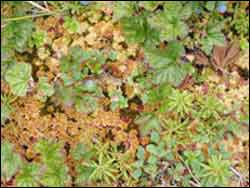Researchers find frozen north may accelerate climate change

The UF study suggests that climate warming in the arctic tundra may cause the release of much more carbon dioxide than previously expected. Even though plants grew more, and more carbon was stored in plants and in the surface of the soil, the whole ecosystem did not gain carbon. Instead, it lost a tremendous amount from the deepest soil layers, probably because increased nitrogen accelerated the breakdown of soil carbon. Credit: Ted Schuur
NASA-funded researchers have found that despite their sub-zero temperatures, a warming north may add more carbon to the atmosphere from soil, accelerating climate warming further.
“The 3 to 7 degree Fahrenheit rise in temperature predicted by global climate computer models could cause the breakdown of the arctic tundra’s vast store of soil carbon,” said Michelle Mack, an ecologist at the University of Florida, Gainsville, Fla., and one of the lead researchers on a study published in last week’s issue of Nature. It would release more of the greenhouse gas carbon dioxide into the air than plants are capable of taking in.
The study results suggest that climate warming in the arctic tundra may cause the release of much more carbon dioxide than previously expected. This type of positive feedback will make the Earth’s climate change even more rapidly. The findings were collected in a 20-year experiment of the effects of fertilization on the arctic tundra at the Arctic Long-Term Ecological Research site near Toolik Lake, Alaska. The National Science Foundation and NASA provided funding for the research.
One-third of the Earth’s soil carbon is locked in northern latitudes because low temperatures and water-saturated soil slow the decomposition of organic matter by bacteria, fungi and other organisms. Scientists from UF, the University of Alaska and the Marine Biological Laboratory at Woods Hole, Mass., added nitrogen and phosphorous fertilizer to the soil to simulate the release of nutrients from decomposing soil organic matter.
The scientists hypothesized the fertilizer would stimulate plant growth, remove carbon from the atmosphere and eventually add it to the soil as plants shed dead leaves and roots over time. Thus, the whole ecosystem was thought to be gaining carbon after fertilization. Mack and her colleagues found exactly the opposite. Even though plants grew more, and more carbon was stored in plants and in the surface of the soil, the whole ecosystem did not gain carbon. “Instead, it lost a tremendous amount from the deepest soil layers, probably because increased nitrogen accelerated the decomposition of organic matter by soil organisms, thereby releasing carbon dioxide.”
The results could have implications for ecosystems in other regions of the world as well, said Edward Schuur, a UF ecologist who co-led the project. Places such as the northeastern U.S. and Europe, where acid rain has increased the amount of nitrogen deposited into the ecosystem from the atmosphere, also could experience an increased loss of soil carbon in response to higher nitrogen inputs. “It may be that not just arctic ecosystems, but those in other parts of the world will have a similar decomposition response to increased nitrogen,” Schuur speculated. “Increased nitrogen levels are thought to have caused trees to grow more in many places. These places may experience the same kinds of effects below ground that we’ve noted.”
Few previous studies have assessed fertilization effects on soil carbon pools because these effects are difficult to detect over short periods of time. The long-term nature of the experiment makes it unique among studies of arctic ecosystems, and makes the effects of fertilization large enough to detect.
It has long been thought that global warming would have two opposing effects on arctic soils. First, would increase the breakdown of soil organic matter, releasing carbon dioxide, the major cause of warming, into the atmosphere. Second, the breakdown of soil organic matter would liberate nutrients that would enhance rates of plant growth, thereby removing carbon dioxide from the atmosphere.
Peter Vitousek, a professor of biological sciences at Stanford University, said “This work demonstrated beautifully that there is another, even stronger effect, that an increase in nutrients also enhances the breakdown of soil organic matter.” The overall effect of warming especially in the Arctic will be to release carbon dioxide to the atmosphere, enhancing the likelihood of further warming.
Media Contact
More Information:
http://www.gsfc.nasa.govAll latest news from the category: Earth Sciences
Earth Sciences (also referred to as Geosciences), which deals with basic issues surrounding our planet, plays a vital role in the area of energy and raw materials supply.
Earth Sciences comprises subjects such as geology, geography, geological informatics, paleontology, mineralogy, petrography, crystallography, geophysics, geodesy, glaciology, cartography, photogrammetry, meteorology and seismology, early-warning systems, earthquake research and polar research.
Newest articles

Parallel Paths: Understanding Malaria Resistance in Chimpanzees and Humans
The closest relatives of humans adapt genetically to habitats and infections Survival of the Fittest: Genetic Adaptations Uncovered in Chimpanzees Görlitz, 10.01.2025. Chimpanzees have genetic adaptations that help them survive…

You are What You Eat—Stanford Study Links Fiber to Anti-Cancer Gene Modulation
The Fiber Gap: A Growing Concern in American Diets Fiber is well known to be an important part of a healthy diet, yet less than 10% of Americans eat the minimum recommended…

Trust Your Gut—RNA-Protein Discovery for Better Immunity
HIRI researchers uncover control mechanisms of polysaccharide utilization in Bacteroides thetaiotaomicron. Researchers at the Helmholtz Institute for RNA-based Infection Research (HIRI) and the Julius-Maximilians-Universität (JMU) in Würzburg have identified a…



